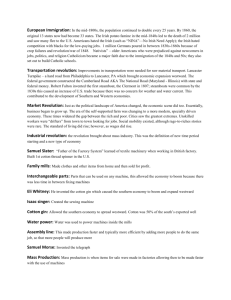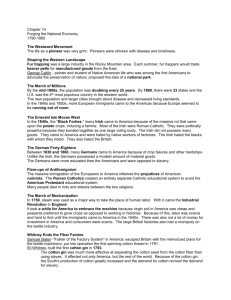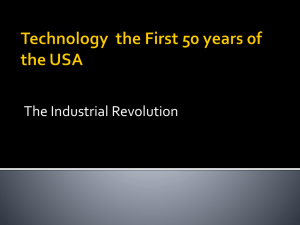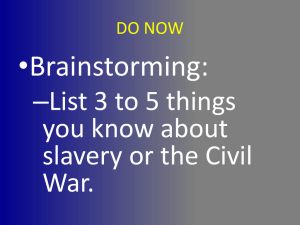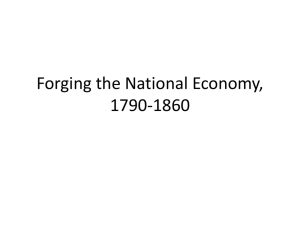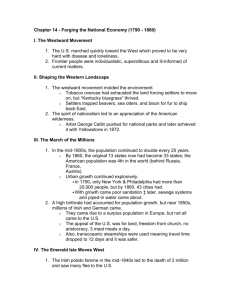power point 14 and 15 - Long Branch Public Schools
advertisement
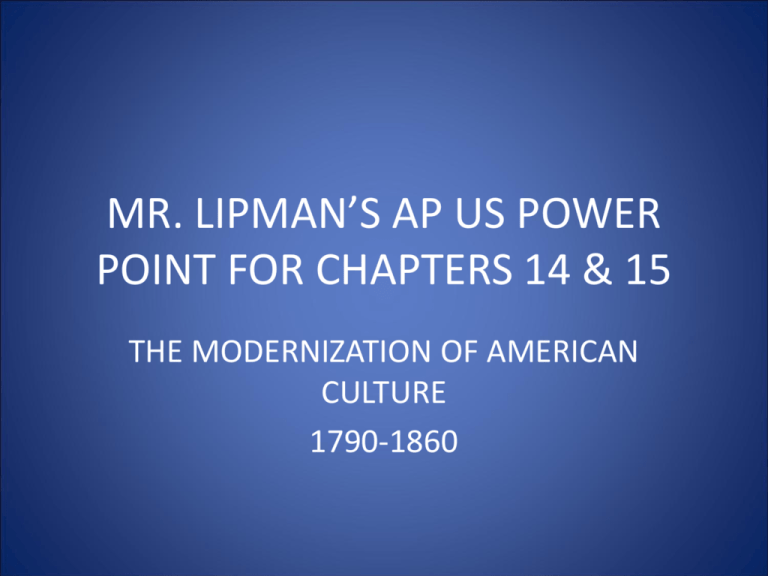
MR. LIPMAN’S AP US POWER POINT FOR CHAPTERS 14 & 15 THE MODERNIZATION OF AMERICAN CULTURE 1790-1860 KEY DEVELOPMENTS • Modernization of the economy on a national basis • The move Westward • Immigration grows • Development of Modern Technology for mass production • Development of Mass Transportation • Development of the Telegraph The Move Westward • Tough life for pioneers • Overuse of land would drive move westward • Fur Trade leads to the “Rendezvous System” in which traders leave St. Louis to go West for pelts and bring manufactured goods with them • Painter George Catlin would call for conservation and a national park system • Massive Immigration leads to doubling of population every 25 years Urban growth – 1860 – 43 cities over 20,000 people ( only 2 in 1790) • N. Y., Chicago, and New Orleans major cities – Problems with quick urbanization • Slums; lack of street lighting, police, clean water, garbage disposal; sewage; rates; loose animals (hogs) in streets • 1823 – Boston first to use sewer system • 1842 – New York used piped-in water • 1845 – 1849 – Irish Potato Famine – – – – – A fungus attacked potatoes 1/4 of Irish (2 million people) died of starvation Huge numbers leaving for US in 1840s and 1850s Crowded into Eastern cities Native whites did not like Irish (NINA) • Blamed for slums and alcoholism – Irish hated blacks – THEY COME TO DOMINATE CITY POLITICAL MACHINES ESPECIALLY IN NEW YORK • Nativists feared Irish and Germans would overwhelm native whites (similar to today) – Taking jobs – Having more babies – Outvoting – Irish Roman Catholicism feared 1849 – Order of the Start-Spangled Banner established • Evolved into powerful American (KnowNothing) party – members were supposed to claim they knew nothing when questioned • Samuel Slater – “Father of the Factory System” in America – Skilled British mechanic attracted to US by bonuses paid to British workers familiar with textile machinery – Memorized plans for British textile machinery and emigrated to US to develop plans (industrial spy) – 1791 – with financial backing of Moses Brown built first American machine for spinning thread • Eli Whitney – Born in Massachusetts; traveled to Georgia – 1793 – invented cotton gin (engine) • Separated seed from short-staple cotton • 50 times more fast than doing it by hand – Cotton became highly profitable, tying South to cotton – Slavery had been dying out; now cotton revived need for slaves to raise cotton and run cotton gin • North and South benefit from cotton gin – South expanded cotton-growing areas – North (and Britain) bought South’s cotton for use in factories • South relied on cotton and slaves; very little manufacturing there • Few US factories until 1807 – Embargo, non-intercourse, War of 1812 led to citizens looking for substitutes for British goods • Hurt New England shipping; capital usually invested in shipping and sailors normally working on ships diverted to factories • Tariff of 1816 passed – Mildly protective tariff to help US manufacturers Eli Whitney develops idea for Interchangeable parts for guns and other items and government buys the weapons Marvels in Manufacturing • 1846 – sewing machine invented by Elias Howe – Perfected by Isaac Singer – Boosted ready-made clothing industry – Moved seamstresses (women sewers) from homeproduction to factories – 1800 – 306 new patents issued – 1860 – 28,000 new patents issued • Changes in form and legal status of business organizations – Limited liability – shareholder liable only for his share of stock in case company went bankrupt – Laws of “free incorporation” • First passed in New York in 1848 • Allow corporations to be formed without applying for individual charters from legislature • The telegraph – 1844 – invented by Samuel F. B. Morse – Wires strung from Washington, DC to Baltimore (about 40 miles) – Morse tapped out “What hath God wrought?” • Benefits and costs of industrialism – Owners grew rich off factory system – Workers : long hours, low wages, child labor rises • Unsanitary work conditions – Forbidden by law to form unions But in 1842 Sup.Ct. rules unions not conspiracies – 1820s-1830s Workers granted the vote • Joined with Democratic party of Andrew Jackson • Worked for 10-hour day, higher wages, better working conditions, public schools, and end to imprisonment for debt Women and the Economy • Before industrialism, women worked at home making clothing and food products needed for home • Factories displaced homemade products, but also offered employment to women • Factory jobs gave women greater economic independence and means to buy manufactured goods • “cult of domesticity” – Working women were single; upon marriage they left their jobs to become wives and mothers – “cult” was widespread cultural belief system that glorified the customary functions of the homemaker – Women’s influence led to changes in the family – Marriage for love instead of arrangement A Revolution in the Fields • Trans-Allegheny region (between Appalachians and Mississippi River) became US’s breadbasket – Especially Ohio-Indiana-Illinois area – Grew corn to be fed to hogs or distilled into liquor (both easier to transport east than corn itself) – Most produce floated down Ohio-Mississippi Rivers to South • Farmers worked to expand acreage – 1837 – John Deere invented steel plow – 1830s – Cyrus McCormick invented the mechanical mower-reaper • 1 man could do work of 5 • Subsistence farming replaced by production for market Farmers went into debt buying more land and new equipment • Obstacles to road building – States’ rights proponents who opposed federal aid to local road projects • Eastern states opposed emigration from their states to West • Cumberland (National) Road – Began in 1811 and finally finished in 1852 – Stretched from western Maryland to Illinois (591 miles) Cumberland (National) Road and Main Connections Steam Boats and Erie Canal Change Everything 1. Robert Fulton 1807 “Claremont” makes up river travel possible 2 .Erie Canal opens 1825 and begins era of canal building as travel time and prices drop rapidly 3. New York becomes the key port The Iron Horse • Early obstacles railroads had to overcome - Canal operators fought against them – Weak brakes ; too much noise; started fires – Inaccurate schedules – Differences in gauge (distance between rails) made railroad lines incompatible (so passengers had to change trains) • 1828 – first railroad in US • 1860 – 30,000 miles of track The Communication Revolution • Transatlantic communication – 1858 – Cyrus Field laid cable across Atlantic (Newfoundland to Ireland) – 1866 – 2nd cable laid after 1st one went dead – Clipper ships improved on speed of Atlantic crossing – Pony Express and Stage coach improved speed to the West Main Routes West Before the Civil War • National division of labor – Sections specialized in certain economic activity – South grew cotton for New England and Britain – West raised grain and livestock for export to East – East made machines and textiles for West and South The Market Revolution • Changes in households because of the market economy – Store-bought goods replaced homemade – Women’s work (homemade things) became unnecessary – Home transformed from place of work to refuge from world and a special area for women as its guardians – Increased gap between rich and poor • As American society changed, REFORMERS worked to erase negative effects of this change: – Many different causes of reform were taken up Religion • Deism (reason and science over the bible) • Unitarianism (god exists in only one) • Second Great Awakening – Began around 1800 as reaction against growing liberalism of religion • Methodists and Baptists gained most converts from camp revivals • Charles Grandison Finney (2nd great awakening) – Trained as lawyer; became preacher after conversion – Massive revivals in 1830 – 1831 in New York – Promised perfect Christian kingdom on earth – Opposed slavery and alcohol – Served as president of Oberlin College (Ohio) • Became center of abolitionist movement • “Burned-Over District” – Western New York, where some New England Puritans moved – Center of revivalist preaching • Great Awakening widened differences: – Eastern areas not affected by revivalism • Upper classes stayed with conservative, traditional churches (Episcopalians, Presbyterians, Congregationalists, Unitarians) – Southern and Western areas most strongly impacted: • Methodists and Baptists grew among poorer, less educated people • 1830 – Church of Jesus Christ of Latter-Day Saints (Mormon) organized by Joseph Smith – Angel delivered plates to Smith, from which he translated the Book of Mormon • Hostility between Mormons and others – Moved from N.Y. to Ohio to Missouri to Illinois – Cooperation in economics and voting angered individualistic Americans • Mormons were accused of polygamy • 1844 – Joseph killed by a mob • Leadership falls to Brigham Young – 1846-47 moves them to Utah – 1857 Federal Army moves against them – 1860s Anti-Polygamy laws passed Public Education Movement – Wealthy afraid of poor, uneducated voters in society in large numbers – Workers demanded education for their children – Public education in South lagged • Upper classes sent children to private schools • Poor whites remained uneducated (in general) • Slaves and free blacks blocked from education • Prior to 1840s one room school houses were quite common and all grades taught at once A One-Room Schoolhouse • Horace Mann – Secretary of Education (Massachusetts) – Wants more and better schools, longer school terms, higher teacher pay, expanded curriculum – His reforms led to changes in other states – Even with reforms, school was still an expensive luxury • Illiteracy and lack of education continued for many • Free blacks kept out of public schools in North and South • Noah Webster’s textbooks – Designed to promote patriotism as well as educate – 1828 – published dictionary that helped standardize American English • Higher education for women discouraged – Should be in home and married, not learning – Too much hurt women’s brains and made them unfit for marriage • State-supported universities – Established first in South (North Carolina first in 1795) – Given federal land on which to build – 1837 – Oberlin (Ohio) College admitted women with men • Insane asylums: Reform led by Dorothea Dix – Insane treated cruelly – Most believed they were willingly depraved – Chained up in prisons with sane • Improved conditions & recognition of mental illness • Heavy drinking – Caused by hard, monotonous life • 1826 – American Temperance Society founded Women in Revolt – Gained strength in 1840s and 1850s • Awakened by Great Awakening – Most were from upper classes – Most worked for other reforms (temperance, abolition) in addition to women’s rights – Important leaders like Lucretia Mott, Elizabeth Cady Stanton, Susan B. Anthony • Dr. Elizabeth Blackwell – First woman graduate of medical college • Margaret Fuller – Edited transcendentalist magazine • Grimké sisters (Sarah, Angelina) – Worked against slavery • Lucy Stone – Kept her maiden name after marriage • Amelia Bloomer – Wore shorter skirt with Turkish pants (“bloomers”) instead of long dresses • 1848: Seneca Falls, New York – Stanton read “Declaration of Sentiments” • “all men and women are created equal” – Demanded the vote – Launched the women’s rights movement • Women’s movement eclipsed by antislavery until after Civil War – Sojourner Truth (former slave) spoke out Attempts at Utopian Societies • Robert Owen – Indiana • Brook Farm- Transcendentalists • Onieda Community- sex without marriage • Shakers- prohibit sex Other Developments • • • • Practical Science John Audubon – study & painting of birds Architecture – copied from Europe Painting – Nationalistic and also the Hudson River school of romantic local scenery Transcendentalism • Roots of transcendentalism – Relaxing of strict Puritanism • Transcendentalist beliefs • Individualism and self-reliance • Hostility to authority and formal institutions Trumpeters of Transcendentalism • Ralph Waldo Emerson – Trained as a Unitarian minister & became lecturer – “The American Scholar” address at Harvard (1837) • Called for American intellectuals to dump European traditions in favor of their own – Essays on self-reliance, improvement, freedom – Strong critic of slavery • Henry David Thoreau – Poet and essay writer; nonconformist transcendentalist – Refused to pay Massachusetts poll tax • Against slavery • Record of 2 years living in hut on Walden Pond • Reduce wants to have time for meditation and study – On the Duty of Civil Disobedience • Influenced Gandhi’s and MLK resistance to oppression through nonviolent confrontation • Walt Whitman – Leaves of Grass (collection of poetry) • • • • • Romantic, emotional, unconventional No titles, stanzas, rhymes Frank talk about sex Not appreciated fully until after his death Celebrated America and pioneering spirit – “Poet Laureate of Democracy” KEY WRITERS OF ERA • • • • Henry Wadsworth Longfellow John Greenleaf Whittier James Russell Lowell Oliver Wendell Holmes • Louisa May Alcott wrote Little Women and other books to help support family • Emily Dickinson wrote poetry as a recluse • Edgar Allen Poe • Nathaniel Hawthorne KEY CULTURAL CHANGES 1820-1860 • • • • • • Modern Economy Movement Westward Immigration Transportation Communication Reform Movements (due to changes taking place) – – – – – – Religion Abolitionist Women Literature Insane Asylums and Prisons Alcohol
